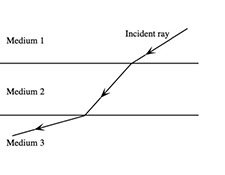
Propagation and refraction of periodic waves
Variant i Dynamics first
Developed by Karen Wosilait and Peter Shaffer
Students relate refraction of periodic waves to changes in the wavelength and phase that occur at the boundary between two media. Wavefront and ray representations are introduced.
Topics Waves and optics / Waves: models, representations, frequency & wavelength, wave (or pulse) speed, and wave front diagrams
Materials
Materials by the UW team
- Equipment List

- Instructor’s Guide


- Sample Pre-test


- Handout


- Sample Exam Questions



Tutorial details
Students begin the tutorial by considering a periodic wave passing from shallow water to deep water at normal incidence. They are told that water waves are observed to travel more quickly in deep water than in shallow. They are prompted to use what they have learned about the behavior of pulses passing from one spring to another to make their predictions.
Next, students are asked to predict the orientation and direction of propagation of several wavefronts generated by a dowel that is rocked back and forth in a shallow pan of water. The dowel is not parallel to any edge of the pan. Students are then instructed to ask an instructor for equipment to check their prediction. We have found it useful for the instructor to ask students a series of questions before giving the students the equipment or demonstrating the experiments. (In a large class, instructors can do this as a group demonstration.) Begin by describing a series of three experiments and asking students to predict the outcomes: (1) the dowel is oriented parallel to the short edge of the pan and is gently rocked back and forth (i.e., the dowel’s direction of motion is perpendicular to its length); (2) the dowel is rotated so that it is not parallel to any edge of the pan, and the dowel is again rocked back and forth; (3) the dowel has the same orientation as in the second experiment, but the direction of motion of the dowel is perpendicular to the short edge of the pan. (This motion cannot be accomplished by rocking the dowel.)
Most students predict that the wavefronts will be oriented parallel to the dowel in each case, but propagate in the direction of motion of the dowel. They fail to recognize that the direction of propagation must be perpendicular to the wavefront. After students have made their predictions, perform the experiment. It is useful to ask students to identify what they observe that helps them identify the direction of propagation of the wavefronts.
In the next part of the tutorial, students consider pulses that do not have normal incidence on a boundary between two regions. Working together in small groups, most groups are able to make qualitatively correct predictions showing how the pulses change as they are transmitted.
Students then consider periodic waves passing from deep water to shallow water at non-normal incidence. They are told the wave speed in the shallow water is half that in the deep water. Students are given a diagram to represent the incident wavefronts and a set of four transparencies with parallel lines. They must choose the transparency that represents the transmitted wave in this case. Students use the observations that they have made to determine how to orient the transparency to represent the transmitted wave.
Students draw wavefront diagrams and ray diagrams to summarize their findings. Students make various errors on their ray diagrams. Many do not correctly identify the angle of incidence and/or the angle or refraction. Others do not draw conventional ray diagrams in which the incident and transmitted rays join at the boundary.
In the final part of the tutorial, students study qualitatively how the angle of incidence affects the angle of refraction. They generalize their results, and they are led to consider whether the ray that represents a wave bends toward or away from the normal as the wave passes into a region with a larger or smaller wave speed.
For instruction tips, login or register as a verified educator to see the Instructor Guide.
Prerequisites
Prerequisite tutorials
The Reflection and transmission of pulses tutorial is a prerequisite to Propagation and refraction of periodic waves.
Other prerequisites
It is expected that students will have worked through the tutorial Reflection and transmission.
Equipment
Special Instructions
Equipment to be placed around tutorial room (2-3 sets)
- 1 baking pan (to serve as “ripple tank”) for water ~0.5 cm deep
- 1 wooden dowel, ~8" long and 1/2" diameter
- 1 eye dropper
- 1 beaker/glass of water
6 envelopes, each containing the following:
- photograph showing water waves incident on boundary between different depths
- diagram (in plastic sheet protector) of waves incident on boundary
- 4 different transparencies (each showing a different set of parallel wavefronts)
Each group should also have an “adjustable angle of incidence” device. (See figure below.) Each requires:
- 2 pieces of cardboard, 8 1/2" × 11", or manila folder cut in half
- paper fastener
- 1 paper copy of Transparency 3 (see above) taped to cardboard (or manila folder) representing a train of parallel wavefronts.

List
- handouts
- paper towels
- water
- white board or large sheet of paper with markers
- beaker or glass of water
Coming Soon! We hope to release the discussion section on each tutorial by the end of July 2024.

